
Solar maxima and minima are closely related to solar cycles, which are periods of about 11 years during which solar activity varies, including the number of sunspots, flares, and solar prominences.
The Sun's activity follows a constant and orderly pattern, and the solar cycle is related to the appearance of sunspots. In the mid-19th century, the periodic presence of enigmatic spots on the surface of the Sun was discovered, which led to the recognition of solar cycles.
Variability in solar activity
In a solar cycle, some maxima may show a high number of sunspots and consequently higher activity, while in other cycles, few or even no sunspots are observed, indicating lower solar activity.
Scientists are working tirelessly to improve their predictions about the strength and duration of these solar cycles, as this has an impact on the conditions of surrounding space, known as space weather.
Each solar cycle lasts approximately eleven years, and a complete cycle takes about twenty-two years for the solar magnetic polarity to return to its initial state.
Solar maximum: time of greatest activity
During solar maximum, the Sun experiences its most active period in the solar cycle. During this phase, the largest number of sunspots is observed on its surface.
In this period, the solar magnetic field lines are distorted due to the differential rotation of the Sun, giving rise to a particular configuration of the star's magnetic field.
Characteristics of solar maximum
Solar maximum is an exciting time for polar aurora observers, but poses risks to astronauts due to exposure to storms of solar radiation.
Additionally, the abundance of solar radiation can negatively affect satellite communications and satellite navigation systems, such as GPS.
Solar minimum: period of lower activity
In contrast, solar minimum is the period of least activity of the Sun in the solar cycle. During this phase, the activity of sunspots and solar flares decreases considerably, sometimes being absent for several consecutive days.
The precise date of the solar minimum is determined by measuring sunspot activity during a period of assumed low activity, meaning that precise identification of the actual date of the minimum occurs six months later.
Identification of the solar minimum
Solar minimum contrasts with solar maximum, since in the latter hundreds of sunspots appear in the Sun's photosphere. During solar minimum, the concentration of radiation emitted by the Sun decreases, making it an optimal period for missions manned space.
Currently, we are experiencing a solar minimum that extends from 2020 to 2055, and presents unique characteristics in terms of depth and duration.
Additionally, the depth of a solar minimum can offer clues about the intensity of upcoming solar cycles and the appearance of sunspots.
Impact on the production of solar thermal and photovoltaic energy
Solar cycles, marked by solar maxima and minima, have a significant impact on the production of both thermal and photovoltaic solar energy. During solar maxima, solar radiation is more intense, which benefits solar photovoltaic power generation. The increased radiation increases the efficiency of the solar panels, which results in greater electricity production.
On the other hand, during solar minimums, greater stability in solar radiation is experienced. This is especially beneficial for solar thermal, which uses the sun's energy to heat fluids and generate electricity or provide heating.
The consistency of solar radiation during solar minima allows for more precise planning and more predictable production.